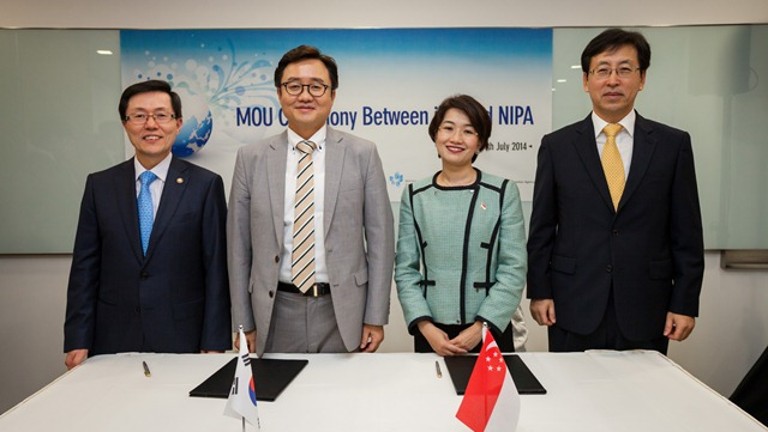For many years now, Singapore’s education system has been touted as a model for many countries – including highly developed ones such as Finland – to draw inspiration from. The island-state, together with fellow Asian nations such as South Korea and Japan, has consistently topped international rankings when it comes to educational standards despite having achieved independence just 49 years ago.

But the system doesn’t work for everyone, and it can be tough on those in society who are stuck in the lower income brackets. Education in Singapore is certainly not cheap. When compared to other countries, Singaporeans pay one of the highest university tuition fees in the world, second only to Ireland. Anders Tan, by his own admission, was one of the many Singaporeans who fell through the cracks in the country’s education system. Tan is now the co-founder of a civic-minded startup called Edusnap. When he was in primary school, he was in the EM3 stream, which was a classification for students achieving poor grades. The streaming system was abolished later on in 2008. The remainder of his education was equally low-prestige.
“I was in the Normal Technical stream in secondary school, and went on to ITE [Institute of Technical Education], followed by polytechnic, and then army, and finally university. It was the long route!” Tan laughs. “Because I don’t come from a rich family, my parents did not have the capability to send me for additional enrichment programs. As a result – and I believe this is one of the main reasons why I wasn’t able to do better in my studies in the earlier days – I gave up studying completely. To me, studying was costly and unfavorable for people who are not rich.” This startup wants to make Singapore’s rigid, expensive education system accessible and free to everyone Tan figured that if you don’t have the cash, you probably shouldn’t study – that’s your destiny in life. However, as he grew older, he began to understand the value of hard work.
“I realised that routes are actually created by yourself.” Things began to come together in his university days. Tan happened to be volunteering at a few organizations at that point in time, where he was helping underprivileged students who did not have access to good education or resources – much like himself. Drawing from his own personal experience as well as those of the students he was helping out together, he decided that students should be able ask questions as and when they need to. “I wanted to create a platform where there are good tutors who are not in it for the money, but truly want to help those who are not as privileged,” he says.
With this in mind, Tan set out to create a platform that would connet willing tutors with students who didn’t have access to mentors like their well-off peers did. After a period of blood, sweat, and coding, Edusnap was born. Edusnap This startup wants to make Singapore’s rigid, expensive education system accessible and free to everyone Edusnap is an app for iOS and Android that allows students to snap and submit pictures of questions that they do not know how to answer. Answers are then furnished by other students, or qualified tutors that have been screened by the team.
Basic education should be free for all
While Edusnap started off as a platform targeting the underprivileged, the team’s vision has expanded to encompass all students regardless of their level of income. “Our idea is this: that basic education should rightfully be free,” explains Chia Luck Yong, who is also a co-founder of Edusnap. “The simple act of asking questions should not come at a cost – students should not be denied the opportunity to ask questions, and hence be disadvantaged, just because they do not have tuition. We want to provide help and assistance in this area.” Edusnap This startup wants to make Singapore’s rigid, expensive education system accessible and free to everyone Why create a mobile app for this, and not a desktop version instead? “We want students to be able to ask questions anywhere they want, and anytime,” says Chia.
“We feel that technology is able to fill this gap that the educational system is not able to cover at the moment.” At the same time, though, they work closely with certain organizations to ensure that needy students get more attention. Tan noted that Edusnap was collaborating with four Voluntary Welfare Organizations (VWOs), where they are working directly with some of SIngapore’s disadvantaged students. For these VWOs, the startup is able to solve a huge problem that they face: the “tutors” that they have in-house, who are actually social workers, are not well-equipped to give these students the enrichment that they require. “These workers have actually left school for many years already, and are hence not trained to be a tutor or educator.
All they can do is read from the book, and teach them whatever is there,” Tan explained. “Meanwhile, other volunteers who come down to help out only visit on a weekly or monthly basis. So the workers find that Edusnap is a very useful tool, because all they need are the relevant smart devices, and they can then use the app to help out their students. In fact, some of the volunteers make use of the app to help out the students even when they are not physically present at the organization. “In this way, VWOs are also able to attract more volunteers to help out as it is far more convenient.” The team was able to get funding through the Social Enterprise Association (SEA) as they fulfilled two important criteria. Firstly, the app helps needy students who could not afford tuition nor mobile devices with their education. Secondly, the team has also gone beyond the app and created a pairing system that matches students to tuition centers located near their homes. Tan says:
We are getting some good responses from both VWOs and tuition centers alike at the moment, because Edusnap complements their systems nicely. We still believe students need to physically attend tuition – we are simply looking to bridge the gap between these places and the underprivileged. To be sure, their core product is still the mobile app. However, the team is willing to do whatever is necessary to give students the help they require. “In fact, the VWOs first approached us to ask if we are able to find more ways to help their students get extra lessons or programs,” Chia explains. “That’s when we reached out to the tuition centers, and it turns out they were more than willing to help – for free!” I was curious as to why tuition centers, which are typically profit-driven, were willing to take on additional students for free. It transpires that tuition centers are more than happy to help out needy students for various reasons, such as corporate social responsibility (CSR) or marketing. The problem lies in the fact that they do not know where and how to find these students, and how to verify if they truly are underprivileged or not. “We are like the middleman in this arrangement – we help tuition centers verify whether the students from these VWOs are really needy or not. In this way, we help save the administrative work on both ends,” says Tan. At the same time, Edusnap is also partnering with 12 tuition centers to help with answering questions on their platform. Similarly, the tutors from these centers who help out do so free of charge.
The billion-dollar question: Reliable or not?
As with any new piece of technology entering the market, Chia admits that they faced a fair bit of skepticism at first – especially from parents. “A lot of parents actually asked us, who are the people answering these questions? As such, we made it a point to personally go down to individual tuition centers to find qualified tutors to be on these platforms to help out,” he explains. Have there been any cases where answers turned out to be wrong? “Sure, we do occasionally get answers that are wrong – even tutors make careless mistakes!” says Chia.
“However, we mitigate this by having a rotation of moderators on board to weed out the incorrect answers, and provide the right ones.” Edusnap This startup wants to make Singapore’s rigid, expensive education system accessible and free to everyone Tan adds that most of these moderators are part-time, but that they do have one in-house moderator. “Students are also able to answer questions on this platform, hence sharing the load with the tutors. Our moderators then go through the answers on a daily basis to ensure quality control.” They are able to do this right now as the platform only receives about 10 to 15 questions per day, though their recent appearance on Singaporean radio channel Capital 95.8FM saw a spike of at least double that number. Currently, Edusnap has about 470 users, which is fairly impressive given that it launched only two months ago and has done no marketing at all until the recent radio appearance.
The platform currently covers only math and science from the primary to tertiary level, but will be looking to expand to other subjects in the future. When it comes to primary school students, parents use the app on the behalf of the kids to ask questions, which appears to be a vote of confidence towards Edusnap. “For students from primary 1 to 4, we usually see their parents asking questions for them,” Chia says.
Creating custom solutions
Chia explains to Tech in Asia that the startup is looking to keep the mobile app free of charge for as long as possible. Instead, they will be monetizing by bringing the platform to schools and tuition centers. He adds: Sometimes, tuition centers and schools don’t want their questions to be shared with the public. What they want is an exclusive Q&A platform for their own use, which we will be providing. There are several web Q&A platforms out there in the market, but none in the mobile space at the moment. This is where we come in – we want to be the first mobile Q&A platform. The team has already finished building this platform and is now working on selling it to to schools in tuition centers. “So far, due to administrative barriers, schools have been slow in responding, but tuition centers seem to be very interested in our platform,” Chia adds. “At this time, two centers have already taken up our solution, with many other queries been made as well.” Initially, the team wanted to charge on a per-question basis. However, they decided not to go for it as it was not in line with their belief that basic education should be free.
Meeting the high demand for tuition throughout Southeast Asia
The startup’s seed funding helped the team to get an ACE Startup Grant. While that money ought to keep the team afloat in its current stage of development, Chia says that that they are looking to raise another round of funding to bring Edusnap overseas as well – specifically to more Southeast Asian countries. “We’ve done some research on countries such as Malaysia, Thailand and Hong Kong, and we see a similar need there,” says Chia.
Tan, who once studied in Thailand, adds, “What we need now is to localize the modules in our app, as our current version only supports the syllabus in Singapore right now.” Singaporeans might assume that the culture of private tuition is unique to the island-state, but it turns out that extra tuition is in high demand everywhere else in Southeast Asia as well. “Countries like Hong Kong have almost similar amounts of spending when it comes to tuition – perhaps even more so than Singapore,” says Tan.
“We want to bring the Singaporean system out there, simply because there is a high demand for it. We complain a lot about our education system here, but other countries both admire and seek to emulate it.” Malaysia seems to be the next country the team is looking to move into. “We have talked to our friends there, as well as looked into their syllabus,” reveals Chia. “One problem we’ve run into is that they are very focused on the Malay language there, which we’re looking to overcome right now.”
Challenges for social entrepreneurs A social enterprise toes the line between being a for-profit and non-profit. The difficulty lies in knowing where to draw the line. Both of the co-founders reveal that one of their biggest concerns at the moment is the lack of income. Neither of them currently draw a salary. “We’re surviving on our savings right now, which is why we’re pushing hard to sign up more corporate partners,” explains Chia. How have their families responded to the path they have chosen to take? “Our families have been really supportive so far. They recognize that this enterprise does good, while at the same time has the potential to earn money as well,” says Tan.
“In any case, we should definitely try it now rather than later on when we have other concerns such as marriage and our own families!” “Ultimately, they do remind us that we must make money in order to survive,” Chia shares. “Like any other social enterprise out there, we need money in order to do good. But I think that as long as we are doing good, our families will definitely continue to support us.”













